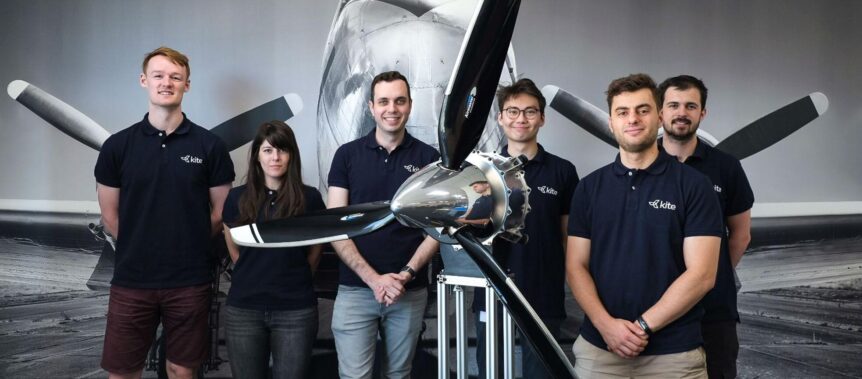Monash University announced a new type of electric aircraft motor and the promise of a fuel that could power everything from your smart watch to your airplane in the future. Both rely on unique ways of seeing the physical world around us.
The Kite Magnetic Motor
Charles Alcock, writing for FutureFlight.com, discusses Kite Magnetics’ 120 kilowatt (160 horsepower) electric propulsion unit (EPU) intended for a variety of light aircraft applications. part of a program at Monash University in Melbourne, Australia, the motor could find applications in “conventional fixed-wing aircraft, as well as eVTOL and eSTOL designs, high-altitude satellites, and wing-in-ground craft,” according to the University.
At its core, the motor relies on the University’s patented Aeroperm™ magnetic material. This lightweight nanocrystalline substance is part of a soft amorphous metal matrix. Unlike traditional iron materials in motors, however, Aeroperm does not exhibit iron’s normal “lossiness.” Instead, it loses energy at “one-tenth the rate of existing magnetic materials used in current electrical devices.”
According to Kite Magnetics CEO Richard Parsons, “This means we can use air cooling even at very high power levels. This makes our motors simpler, more reliable, and extremely lightweight.” Kite characterized that weight as “around as much as a full suitcase.”
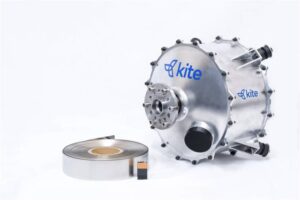
Kite Magnetics’ KM-120 with roll of Aeroperm™ nanocrystalline core material
PV-Magazine Australia reported a little more definitively. “The new KM-120 measures 300 mm (11.8 inches) x 387 mm (15.2 inches) and weighs in at 23 [kilograms] (50.6 pounds), a figure that rises to 35 kgs (77 pounds) when all the mountings, flange, etc are included. The company is now accepting orders for its new motors and expects to begin shipping to existing customers over the coming year.” In comparison, the Rotax 277, an old-school two-stroke ultralight powerplant, weighed 75 pounds with exhaust and produced 27 horsepower (about 20 kilowatts).
Parsons explained two different growth paths for the motor firm. “Parsons stated. “In the longer term, Kite plans to scale up the technology to develop and certify a 650-kilowatt electric propulsion unit that could replace turboprop engines on aircraft such as the Cessna Grand Caravan. It also envisages integrating the Aeroperm technology with larger propulsion systems using hydrogen fuel cells intended for regional airliners.”
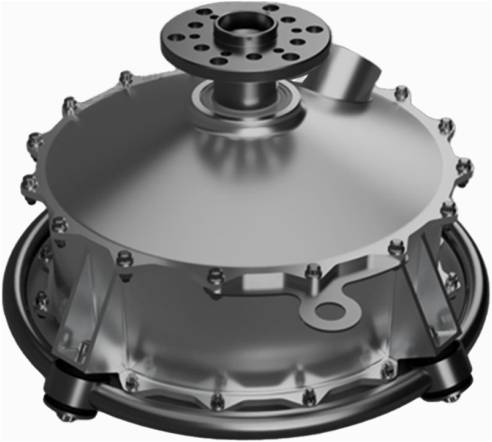
KM-60 would provide 85 horsepower from motor half the size and weight of KM-120
Kite is also possibly producing a smaller motor, the KM-60, probably half the weight and output. A 12-kilogram (26.4 pound) electric motor producing around 65 kilowatts (87 horsepower) would really open up the Light Sport Aircraft (LSA) market. To top it all, they will supply motor makers with their amorphous soft metal core material custom made for specific applications .
Starting less than a year ago with an initial funding of $1.85 million (Australian), or about $1.2 million US, the University-affiliated operation has made serious inroads into production rather quickly. Parsons intends to achieve type certification under Part 23 rules, “starting with Australia’s Civil Aviation Safety Authority, and later with the FAA and EASA to access the U.S. and European markets.”
With a range of motor offerings in the offing, and what seems to be a new material for other motor developers to investigate, all Kite Magnetics needs is an energy source. For those who want to learn more, Richard Parsons writes well-done blog entries on motor and inverter basics. The blog will probably grow over time to include other aspects of electric aviation.
Generating Hydrogen from Thin Air
Monash PhD student Ashleigh Kropp and Dr. Rhys Grinter from the University Biomedicine Discovery Institute have discovered an enzyme that converts air into energy. The enzyme “uses the low amounts of the hydrogen in the atmosphere to create an electrical current. This finding opens the way to create devices that literally make energy from thin air,” according to Futurism.
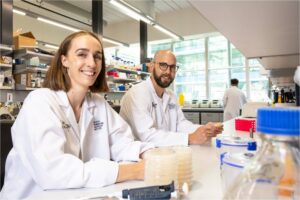
PhD. candidate Ashleigh Kropp and Dr. Rhys Grinter are exploring the potential for pulling energy from thin air
The finding, published in the journal Nature, explains that Mycobacterium smegmatis, a common soil bacterium, uses and enzyme called Huc to convert atmospheric hydrogen into an electrical current. This “extraordinarily efficient” enzyme consumes hydrogen below atmospheric levels – “0.00005 percent of the air we breathe, and makes it into electricity.
“We’ve known for some time that bacteria can use the trace hydrogen in the air as a source of energy to help them grow and survive, including in Antarctic soils, volcanic craters, and the deep ocean,” Professor [Chris] Greening, [head of the One Health Microbiology group] said. “But we didn’t know how they did this, until now.”
Ms. Kropp has shown Huc is stable and storable for long periods. It retains its power to generate electricity even when frozen or heated to over 80 degrees Celsius.
Huc is a “natural battery” that produces a sustained electrical current from air or added hydrogen. While this research is at an early stage, the discovery of Huc has considerable potential to develop small air-powered devices, for example as an alternative to solar-powered devices.
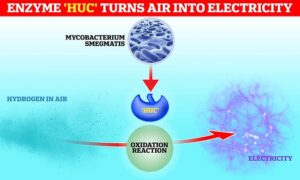
Huc transforms H2 into electricity
The bacteria that produce enzymes like Huc are common and can be grown in large quantities, meaning we have access to a sustainable source of the enzyme. Dr. Grinter says that a key objective for future work is to scale up Huc production. “Once we produce Huc in sufficient quantities, the sky is quite literally the limit for using it to produce clean energy.”
This would seem to be inexhaustible with bacteria removing 77 million tons of hydrogen from the air. It might not be potent enough to help power an entire airplane (see your editor’s article, “The Grand Unified Airplane,” Kitplanes, 2013) but it might run instruments or radios.

